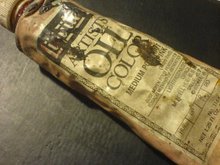MUTINY FOR THE MUSEUMS
Still-unpublished (and still-unpaid for!) manuscript. Supposed to be the final story for a new publisher's revamped magazine's aborted special issue on Collecting. December 2005.
The era of dirt-cheap Philippine art is about to end.
Increasing international demand, an exodus of visionaries, and skyrocketing production/ exhibition costs will finally be allowed to take their toll, in a last-ditch attempt to ensure the domestic supply of art worth having. From 2007 onwards -- when the decimation of the ranks begins to show -- I personally foresee a 15-35% show-to-show price increase for good new art, continuing indefinitely until the art market becomes sustainable. You see, it never really was.
For the longest time, prices were maimed by a cocktail of reasons that would've killed off any other field of collecting. The usual suspects were there, of course: the castrated peso, the former dearth of insurance options and secure logistics; the low media exposure due to envelopmental journalism; and the price caps by collector cartels who realized that the geese wouldn't stop laying golden eggs anyway, regardless of how little or how belatedly they got paid for it. The art market only survived because it was heavily subsidized by working-class parents who couldn't bear to see their mutant children starve, and by gallery owners who either earned their fortunes elsewhere (neurologist, publishing heiress, etc), or who had successful children funding their galleries out of filial piety.
 Cesar Legaspi, CIRCA 1971 (CRUCIFIXION), 1971. Oil on masonite. 47 x 66 in. P8,500,000.
Cesar Legaspi, CIRCA 1971 (CRUCIFIXION), 1971. Oil on masonite. 47 x 66 in. P8,500,000.Photo courtesy Galleria Duemila.
But this was only half the story. Layered over the usual suspects were two cardinal sins that essentially legitimized and condoned the exploitation:
First was the government's post-Marcos de-prioritization of art and culture in both funding and education, purportedly for reasons of economic survival, despite economic progress actually being a cultural process, and despite art (as condensed culture) being key to the removal of cultural obstacles to economic development. That such a de-prioritization could come from a country desperate for international respect is especially ironic, of course, because the extent and conservation of culture is precisely what countries need to showcase to each other to gain respect, and art (as tangible expressions of national soul) is precisely what countries must lend each other as proof of trust and acceptance.
The second sin sadly came from within art itself. Ever since the 1970's, artists worldwide have thrown themselves into exploitation in obedience to a devastatingly stupid bohemian dogma that equates artistic integrity with anti-market sentiments, a dogma complicated in the Philippine context by the further equation of artistic integrity with nationalism.This cocktail resulted in the quicksand otherwise known as Philippine Art: thousands of artists sabotaging family finances in patriotic opposition to globalization, although they're the only socio-economic sector that would've survived the globalization of a nation that never loved them anyway.
Who did this exercise in futility benefit most? Those who scrimped on art to splurge on, to cite one particularly egregious example, a US$6,000 porcelain rooster (I know who you are, you scumbag).
Eventually, cultural exchange awakened local artists to just how good they are -- the Philippine record in the ASEAN Art Awards is unrivalled, for example -- and to just how badly they are treated here, compared to artists in countries sometimes even poorer than their own. Market-friendly heresies have also taken root, fertilized by the chilling realization that many of the Western anti-materialist prophets they followed were actually pensioned aristocrats who never needed a job, or worse, charlatans who actually became rich from their anti-materialist demagoguery (e.g., Joseph Kossuth & his ilk).
 Leonard Aguinaldo, Ay Apo, 2005. Hand-colored, hand-carved rubber. 54 x 52 ins. P110,000.
Leonard Aguinaldo, Ay Apo, 2005. Hand-colored, hand-carved rubber. 54 x 52 ins. P110,000.Photo courtesy Galleria Duemila.
And so begins a new exodus of Philippine art. In the 1960's, Juan Luna's fed-up daughter-in-law finally retaliated to government parsimony by hurling 64 of the Master's works out of the country. It took two decades and a bank's fortune to buy the works back and repatriate them. But we never learned. Latest reports say we've already lost over 90% of our cultural heritage to war and neglect, and that two container vans worth of cultural artifacts are reportedly still smuggled out of the country every single day.
At any rate, today is the 1960s all over again, on an epic scale. This time, even the geese are fleeing. The last three years alone have witnessed over a dozen disillusioned visionaries either leaving art (e.g., Len Familara into NGO work), leaving the country (e.g., Imelda Cajipe-Endaya migrating to New York), or both (e.g., Ringo Bunoan opening a restaurant in Kathmandu). And those stuck here are increasingly focusing on foreign audiences: In 2002, for example, while pundits whined about GSIS spending US$860,000 for Luna's Parisian Life, a Madrid gallery was reportedly selling another Luna for US$10 Million. And just last October, Sothebys Singapore sold a painting by young Luzon artist Geraldine Javier for nearly double the high estimate. The painting was barely six months old.

Geraldine Javier, TWO MARYS, 2005. Oil on canvas diptych, 4 x 3 ft per panel, price upon request.
Photo courtesy Valentine Willie Fine Art, Kuala Lumpur.
Mercifully, an entirely new species of collector has emerged. Not all of these collectors are rich, and some of them may never be. And too few of them collect art as of yet. But their sumptuary code -- their ethics of consumption, if you will -- is so anti-exploitative, that they are practically in mutiny against their predecessors. They are my Abubot Babies. Soon, the doors of galleries will exclude everyone who wouldn't shop like they do.

Anton del Castillo, RACE TO THE END, 2005. Oil on 22kt gold leaf, 4 x 12 ft, P200,000.
Photo courtesy the artist.
The Abubot Babies are essentially luxury-literate, thirty-something Pinoy techno-yuppies with strong humanities backgrounds and stronger consciences. Many of them wanted to be artists as children, but just had to be "more practical" in adulthood (for instance, the friend who taught me watercolor 16 years ago is now the eminently Google-able hotshot property consultant David Francis Leechiu). Most of them are self-made. None of them spend like the noveau-riche.
They take pay cuts for meaningful projects, believing that the best income is money earned by doing what they love. They believe in corporate social responsibility. They try to change society from the inside. They treat their employees fairly, and pay them decently.
They don't buy fake, because they work with data and discourse, and they define themselves by the symbols they consume.
They are wary of antique furniture for one feng-shui reason or the other. Even if money were no object, they'd rather buy a new Hickory Chair reissue of an old design, than buy the ghost-ridden antique that the company drew inspiration from.
They want exceptional, handcrafted status symbols in their homes, but are turned-off by the carnage, exploitation and deceit associated with the trade in ivory, ethnographic artifacts, and older Philippine art.
They don't mind paying premiums to get first choice at exceptional products. They already do for luxury goods that eventually get knocked off anyway, or for tech gear that everybody else will have later on.
And, wealthy or not, they think haggling is for social climbers. If the price is not fair, they simply walk away. If the price is fair but too painful to "American Express it," the furthest they would go is MasterCard deferred for 36 months, possibly refinanced somewhere down the road. After all, they don't haggle at Chanel or Vuitton. They should see no need to haggle at an art gallery whose products don't even depreciate.

Nona Garcia, NEW SPECIMEN, 2003. Oil on canvas, 71 x 42 ins. P62,000.
Photo courtesy Galleria Duemila.
Obviously, people who shop like this will eventually turn to the art of their time. Art (as embodied meaning) is the ultimate collectible of the avatar age, anyway.
But what art will they patronize? Four preferences can safely be assumed:
1. Flawless construction, visible or otherwise. Rolex, Ozwald Boateng, Macanudo, Asprey, and Hermes have spoiled them that way.
2. Craftsmanship celebrated, as taught by Fendi, Bottega Venetta, Elie Saab & Roberto Cavalli. Also, many of these kids can draw. They or their friends will be able to spot bullshit in the galleries when they see it.
3. Intellectual integrity. Yohji Yamamoto, Vivienne Westwood, & Takashi Murakami have taught these kids to respect intellectual property. They will not take kindly to artists slavishly knocking off other artists' styles. They dislike like the watered-down art usually peddled by interior designers.
4. Unapologetic, drop-dead gorgeousness. As a matter of survival, these kids grew up trying to resist sophisticatedly seductive ads of sophisticatedly seductive objects. If a particular artwork cannot visually compete with a 20-inch iMac G5, a Bulgari Astrale, or a metallic red 2007 Jaguar XK, it won't even register on their radar.

Francesca Enriquez, DYNASTY ROOM, 2005. Oil on canvas, 22 x 19 inches. P50,000.
Photo Courtesy Finale Art File.
Miraculously, as if to ease the Abubot Babies into art collecting, two global art trends will soon affect local artistic production: the decline of political art (soon to be legitimized, I've learned, by the 2007 Venice Biennale), and the return of academic realism after Postmodernism was discredited by the WTC bombings. Properly harnessed, I believe this new cocktail can usher in a new golden age of Philippine art, and finally force the country to pay attention to it.
Crippled and neglected as it still is, you see, the legacy of Philippine art is already mind-boggling: Amorsolo alone produced an estimated 25,000 paintings, plus a similar number of drawings, with the better paintings starting at P3 million on a good day, and with the masterpieces going for P22-P40 million.
I can only imagine how things will be for artists, the economy, and even the country, when the sun finally rises, and the Abubot Babies finally join this mutiny for the museum.

Photo courtesy Galleria Duemila.
SIDEBAR: ADVICE FOR THE YOUNG AT ART
1. Visit every exhibit you can. Find out why you like what you like. Looking costs you nothing, and is still the only way to develop an eye.
2. Never let your interior designer choose art for you. By instinct, she will merely get art that complements the furniture, when she's supposed to aim higher, and get furniture that complements the art.
3. Identify the trustworthy art dealers (there are many crooks among them), and allow the good guys to make money off you. Just write it off as your matriculation and research costs. Dealers need a buffer, you see. They’re the ones who have to find & incubate new talent, and they lose almost P100,000 a week (plus financing costs) when showing important-but-hard-to-sell art.
4. Don’t haggle; you’re not buying fish. If you can’t afford it, don’t buy it. If the art is any good, its value will increase with age, anyway, and you’ll eventually get your money’s worth. Besides, most galleries work by commission, so the poor artist will be shouldering up to 70% of whatever discounts you wring out of the gallery.
5. Unless you’re a cultural worker yourself, never discuss business with artists inside their homes. It is an abuse of hospitality. If you like something in the studio, grab your cell and call the artist’s dealer. If the artwork hasn’t been promised to a dealer yet, then at least step out of the house before you offer to buy. And please have the decency to volunteer a premium for the privilege of First Refusal. Art should NOT be cheaper at the source. It is neither cattle nor vegetables nor furniture.
6. Unless it's at at a formal exhibition mounted by a Selling Curator, non-cultural workers should never EVER buy art from students. It’s the artworld equivalent of statutory rape.







No comments:
Post a Comment